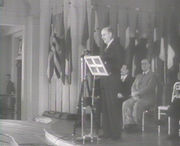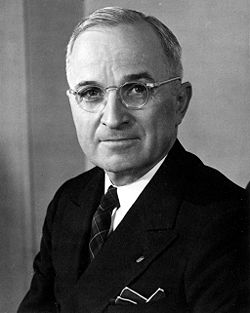Henry Morgenthau, Jr.
| Henry Morgenthau, Jr. | |
 |
|
|
|
|
|---|---|
| In office January 1, 1934 – July 22, 1945 |
|
| President | Franklin D. Roosevelt (1934-1945) Harry S. Truman (1945) |
| Preceded by | William Hartman Woodin |
| Succeeded by | Frederick Moore Vinson |
|
|
|
| Born | May 11, 1891 New York City, New York |
| Died | February 6, 1967 (aged 75) Poughkeepsie, New York |
| Signature | |
Henry Morgenthau, Jr. (pronounced /ˈmɔrɡənθɔː/; May 11, 1891 – February 6, 1967) was the U.S. Secretary of the Treasury during the administration of Franklin D. Roosevelt. He played a major role in designing and financing the New Deal. After 1937, while still in charge of the Treasury, he played an increasingly major role in foreign policy, especially with respect to policies supporting China, helping Jewish refugees, and (in the "Morgenthau Plan") in reducing the future war-making potential of Germany after the Allied victory in 1945.
Contents |
Early life
Morgenthau was born into a prominent Jewish family in New York City, the son of Henry Morgenthau Sr., a real estate mogul and diplomat, and Josephine Sykes. He had three sisters. He attended what is now The Dwight School. Later, he studied architecture and agriculture at Cornell University. He operated a farm near the Roosevelt estate in upstate New York, specializing in growing Christmas trees. In 1913, he met and became friends with Franklin and Eleanor Roosevelt. During World War I, he worked for the Farm Security Administration. In 1929, Roosevelt, as Governor of New York, appointed him chair of the New York State Agricultural Advisory Committee and to the state Conservation Commission.
New Deal

In 1933, Roosevelt became President and appointed Morgenthau governor of the Federal Farm Board. Morgenthau was nonetheless involved in monetary decisions. Roosevelt adopted the idea of raising the price of gold to drive down the value of the dollar, thereby raising the price of all goods — especially farm goods. The idea came from Professor George Warren of Cornell University, and despite the opposition to the idea, Morgenthau was willing to help him. When Roosevelt told Morgenthau he was thinking of raising the price of gold by 21 cents, his entourage asked him why. "It's a lucky number," Roosevelt said. "Because it's three times seven." As Morgenthau later wrote, "If anybody knew how we really set the gold price through a combination of lucky numbers, etc., I think they would be frightened." [1]
In 1934, when William H. Woodin resigned because of poor health, Roosevelt appointed Morgenthau Secretary of the Treasury (an act that enraged conservatives). Morgenthau was an orthodox economist who opposed Keynesian economics and disapproved of some elements of Roosevelt's New Deal. To finance World War II, he initiated an elaborate system of marketing war bonds.
Fiscal responsibility
Morgenthau believed in balanced budgets, stable currency, reduction of the national debt, and the need for more private investment. The Wagner Act regarding labor unions met Morgenthau’s requirement because it strengthened the party’s political base and involved no new spending. Morgenthau accepted Roosevelt’s double budget as legitimate — that is, a balanced regular budget, and an “emergency” budget for agencies, like the Works Progress Administration (WPA), Public Works Administration (PWA) and Civilian Conservation Corps (CCC), that would be temporary until full recovery was at hand. He fought against the veterans’ bonus until Congress finally overrode Roosevelt’s veto and gave out $2.2 billion in 1936. In the 1937 "Depression within the Depression," Morgenthau was unable to persuade Roosevelt to desist from continued deficit spending. Roosevelt continued to push for more spending, and Morganthau promoted a balanced budget. On November 10, 1937, Morgenthau gave a speech to the Academy of Political Science at New York's Hotel Astor, in which he noted that the Depression had required deficit spending, but that the government needed to cut spending to revive the economy. In his speech, he said:[2]
-
"We want to see private business expand. … We believe that one of the most important ways of achieving these ends at this time is to continue progress toward a balance of the federal budget."
Amity Shlaes, in her book The Forgotten Man, records that "a laugh came from the crowd — someone's laugh of contempt." [3] In fact, it was hard for the business community to believe that Morgenthau, who had presided over the decline of the dollar and the rising federal deficit — really could believe in balancing the budget.
His biggest success was the new Social Security program; he reversed the proposals to fund it from general revenue and insisted it be funded by new taxes on employees. Morgenthau insisted on excluding farm workers and domestic servants from Social Security because workers outside industry would not be paying their way.[4] He is quoted in doubting the huge spending schemes in The New Deal that haven't reduced unemployment and only added debt:[5]
-
"We have tried spending money. We are spending more than we have ever spent before and it does not work. And I have just one interest, and if I am wrong … somebody else can have my job. I want to see this country prosperous. I want to see people get a job. I want to see people get enough to eat. We have never made good on our promises. … I say after eight years of this Administration we have just as much unemployment as when we started. … And an enormous debt to boot."
Jewish refugees
Once confronted by the Holocaust, the Allied Powers reacted slowly. Refusing the initial appeal of Jewish organizations for Allied countries to deliver food and medicine to the ghettos of Europe, the British and U.S. governments argued that supplies would be diverted for the Germans' personal use or would be granted to the Jews just to free the Third Reich from its "responsibility" to feed them. A license granted in December 1942 for such shipments had minimal effect. In 1943, the Treasury Department approved the World Jewish Congress' plan to rescue Jews through the use of blocked accounts in Switzerland, but the State Department and the British Foreign Office procrastinated further. Morgenthau and his staff persisted in bypassing State and ultimately confronting Roosevelt in January 1944, along with increasing calls from Congress and the public for a presidential rescue commission; the eventual result was the executive creation of the US War Refugee Board in January 1944. The Board allowed an increasing number of Jews to enter the U.S. in 1944 and 1945; as many as 200,000 Jews were saved in this way.[6]
Hurwitz (1991) argues that in late 1943, the Treasury Department drafted a report calling for the creation of a special rescue agency for European Jewry. At the same time, several congressmen connected with the "Bergson Boys" introduced a resolution also calling for the creation of such an agency. On January 16, 1944, Morgenthau presented Roosevelt with the Treasury report, and the president agreed to create the War Refugee Board (WRB), the first major attempt of the United States to deal with the annihilation of European Jews.
Execution of Nazi criminals
Morgenthau advocated the summary execution without trial of the top 50 or 100 Nazi criminals[7] and had some success, but in the end the Nuremberg trials became the chosen option.
Controversy surrounding the Morgenthau Plan
In 1944, Morgenthau proposed the Morgenthau Plan for postwar Germany, calling for Germany to be dismembered, partitioned into separate independent states, stripped of all heavy industry and forced to return to a pre-Industrial Revolution agrarian economy. The Morgenthau plan is thought by a few to have been devised by Morgenthau's deputy, Harry Dexter White[8], who was later accused of being a Soviet agent.[9] At the Second Quebec Conference on September 16, 1944, Roosevelt and Morgenthau persuaded the initially very reluctant British Prime Minister Winston Churchill to agree to the Morganthau plan, likely using a $6 billion Lend Lease agreement to do so.[10] Churchill chose however to narrow the scope of Morgenthau's proposal by drafting a new version of the memorandum, which ended up being the version signed by the two statesmen.[10] The gist of the signed memorandum was "This programme for eliminating the war-making industries in the Ruhr and in the Saar is looking forward to converting Germany into a country primarily agricultural and pastoral in its character."
The plan faced opposition in Roosevelt's cabinet, primarily from Henry L. Stimson (see also his memorandum), and the leakage of the plan to the press resulted in public criticism of Roosevelt.[11] The President's response to press inquiries was to deny the press reports.[12] As a consequence of the leak, Morgenthau was in bad favor with Roosevelt for a time.
German Propaganda Minister Joseph Goebbels used the leaked plan, with some success, to encourage the German people to persevere in their war efforts so that their country would not be turned into a "potato field." [13] General George Marshall complained to Morgenthau that German resistance had strengthened.[14] Hoping to get Morgenthau to relent on his plan for Germany, Roosevelt's son-in-law, Lt. Colonel John Boettiger, who worked in the United States War Department, explained to Morgenthau how the American troops that had had to fight for five weeks against fierce German resistance to capture Aachen and complained to him that the Morgenthau Plan was "worth thirty divisions to the Germans." Roosevelt's election opponent in late 1944, Thomas Dewey, said it was worth "ten divisions". Morgenthau refused to relent.[15]
On May 10, 1945, Truman signed the U.S. occupation directive JCS 1067. Morgenthau told his staff that it was a big day for the Treasury, and that he hoped that "someone doesn't recognize it as the Morgenthau Plan."[16] The directive, which was in effect for over two years directed the U.S. forces of occupation to "…take no steps looking toward the economic rehabilitation of Germany".[17]
In occupied Germany Morgenthau left a direct legacy through what in OMGUS commonly were called "Morgenthau boys". These were U.S. Treasury officials whom General Dwight D. Eisenhower had "loaned" in to the Army of occupation. These people ensured that JCS 1067 was interpreted as strictly as possible. They were most active in the first crucial months of the occupation, but continued their activities for almost two years following the resignation of Morgenthau in mid 1945 and some time later also of their leader Colonel Bernard Bernstein, who was "the repository of the Morgenthau spirit in the army of occupation".[18] They resigned when in July 1947 JCS 1067 was replaced by JCS 1779 which instead stressed that "An orderly, prosperous Europe requires the economic contributions of a stable and productive Germany."
Morgenthau's legacy was also seen in the plans for preserving German disarmament by significantly reducing German economic might.[19] (see also The industrial plans for Germany)
In October 1945 Morgenthau published a book[20] in which he described and motivated the Morgenthau plan in great detail. Roosevelt had granted permission for the book the evening before his death, when dining with Morgenthau at Warm Springs. Morgenthau had asked Churchill for permission to also include the text of the then still secret "pastoralization" memorandum signed by Churchill and FDR at Quebec but permission was denied.[21] In November 1945 General Dwight D. Eisenhower, the Military Governor of the U.S. Occupation Zone, approved the distribution of 1000 free copies of the book to American military officials in occupied Germany. Historian Stephen Ambrose draws the conclusion that, despite Eisenhower's later claims that the act was not an endorsement of the Morgenthau plan, Eisenhower both approved of the plan and had previously given Morgenthau at least some of his ideas on how Germany should be treated.[22]
Following his resignation, and in company of other prominent individuals such as the former first lady Eleanor Roosevelt, Morgenthau remained for several years an active member of the campaign group for a "harsh peace" for Germany.[23]
Bretton Woods

Morgenthau was a leading participant in the Bretton Woods Conference, which established the Bretton Woods system, the International Monetary Fund and the International Bank for Reconstruction and Development (the World Bank).
Later career and legacy
Morgenthau resigned in mid-1945, when Truman became President and Morgenthau's advice was no longer sought. He devoted the remainder of his life to working with Jewish philanthropies, and also became a financial advisor to Israel. Tal Shahar, an Israeli moshav (agricultural community) near Jerusalem, created in 1948, was named in his honor (Morgenthau means "morning dew" in German, and so does the Hebrew name "Tal Shahar").
Morgenthau died in Poughkeepsie, New York, in 1967.
The 378-foot (115 m) United States Coast Guard Cutter Morgenthau is named in his honor.
Other information
As Secretary of the Treasury, Morgenthau was first person in the presidential line of succession from June 27 to July 3, 1945, following the resignation of Secretary of State Edward Stettinius and the U.S. Senate confirmation of James Byrnes. Had President Truman died, resigned or been removed from office otherwise during those seven days, Morgenthau would have become Acting President of the United States until the end of the presidential term in 1949.
Notes
- ↑ Amity Shlaes, The Forgotten Man (2007), p. 163, 148
- ↑ Amity Shlaes, The Forgotten Man (2207) pp. 341-42.
- ↑ Amity Shlaes, The Forgotten Man (2207) pp. 342.
- ↑ Julian E. Zelizer; "The Forgotten Legacy of the New Deal: Fiscal Conservatism and the Roosevelt Administration, 1933-1938." Presidential Studies Quarterly. Volume: 30. Issue: 2. 2000. pp 331+.
- ↑ "Patterico's Pontifications: A Quote to Start Your Day". March 2, 2009. http://patterico.com/2009/03/02/a-quote-to-start-your-day. Retrieved September 6, 2009.
- ↑ Penkower 1980
- ↑ War crimes against women: prosecution in international war crimes tribunals By Kelly Dawn Askin p.105 (Google books)
- ↑ J.M. Boughton. "The Case Against Harry Dexter White: Still Not Proven," IMF Working Paper 00/149, finds that White's proposals were much less extreme than Morgenthau's.
- ↑ FBI file: Underground Soviet Espionage Organization (NKVD) in Agencies of the United States Government, October 21, 1946, p. 78-79 (PDF pp. 86-87)
- ↑ 10.0 10.1 John L. Chase "The Development of the Morgenthau Plan Through the Quebec Conference" The Journal of Politics, Vol. 16, No. 2 (May, 1954), pp. 324-359
- ↑ The Policy of Hate, Time magazine, Oct. 02, 1944
- ↑ The Battle for Peace Terms, Time magazine, Oct. 09, 1944
- ↑ Office of Strategic Services Official Dispatch, Franklin D. Roosevelt Presidential Library and Museum, Marist College
- ↑ Report on the Morgenthau Diaries, p. 41ff
- ↑ Michael R. Beschloss, The Conquerors: Roosevelt, Truman and the Destruction of Hitler's Germany, 1941–1945, pg. 172-173.
- ↑ Beschloss, The Conquerors, pg. 233.
- ↑ Pas de Pagaille! Time Magazine, Jul. 28, 1947.
- ↑ Vladimir Petrov. Money and conquest; allied occupation currencies in World War II. Baltimore, Johns Hopkins Press (1967) pg. 228-229 OCLC 186795
- ↑ Frederick H. Gareau "Morgenthau's Plan for Industrial Disarmament in Germany", the Political Research Quarterly, Vol. 14, No. 2 (June, 1961), pp. 517-534
- ↑ Germany Is Our Problem. Harper and Brothers, 1945
- ↑ Beschloss, The Conquerors, p. 250
- ↑ Ambrose, Stephen, Eisenhower: Soldier, General of the Army, President-Elect (1893-1952), New York: Simon and Schuster, 1983, p. 422. ISBN 978-0671440695
- ↑ Steven Casey, "The campaign to sell a harsh peace for Germany to the American public, 1944–1948". History, 90 (297). pp. 62–92. (2005) ISSN 1468-229X
References
- Beschloss, Michael. The Conquerors: Roosevelt, Truman and the Destruction of Hitler's Germany, 1941–1945. Simon & Schuster. 2002. ISBN 0-684-81027-1. Devotes much attention to Morgenthau Plan
- Hurwitz, Ariel. "The Struggle over the Creation of the War Refugee Board (WRB)" Holocaust and Genocide Studies 1991 6(1): 17-31. ISSN 8756-6583
- Penkower, Monty Noam. "Jewish Organizations and the Creation of the U.S. War Refugee Board." Annals of the American Academy of Political and Social Science 1980 (450): 122-139. ISSN 0002-7162 Fulltext in Jstor
- Zelizer, Julian E. "The Forgotten Legacy of the New Deal: Fiscal Conservatism and the Roosevelt Administration, 1933-1938." Presidential Studies Quarterly. Volume: 30. Issue: 2. 2000. pp 331+.
- Vladimir Petrov. Money and conquest; allied occupation currencies in World War II. Baltimore, Johns Hopkins Press (1967)
Primary sources
- Blum, John Morton, ed. From the Morgenthau Diaries, a 3-volume narrative of Morgenthau's New Deal years (1928–45) based very closely on his diary.; abridged edition: Roosevelt and Morgenthau: A Revision and Condensation of From the Morgenthau Diaries (1972)
Further reading
- Bacque, James. Other Losses. Fenn Publishing (2d. rev. ed., 1999)
External links
- Time Magazine October 15, 1945 Morgenthau's Hope Reaction to the publication of Morgenthau's book "Germany is Our Problem" where he promotes the "Morgenthau Plan".
- Time Magazine September 22, 1967 Vengeance v. Vision Review of Yars of War, 1941–1945; From the Morgenthau Diaries by John Morton Blum.
- U.S. Treasury - Biography of Secretary Morgenthau
- Stay the Hand of Vengeance by Gary Bass
| Political offices | ||
|---|---|---|
| Preceded by William H. Woodin |
United States Secretary of the Treasury Served under: Franklin D. Roosevelt, Harry S. Truman 1934–1945 |
Succeeded by Fred M. Vinson |
|
|||||||
|
|||||||||||||||||||||||||||||||||||||
|
||||||||||||||||||||||||||||||||||||||||
|
|||||||||||||||||


